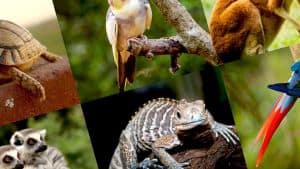The importance of organisms in an ecosystem is that ecosystems and organisms complement each other and are interdependent.

Interdependence in nature can be illustrated by the transfer of energy between organisms and their environment.
For example, plants get their energy from soil and sunlight. They capture carbon dioxide from the environment and synthesize oxygen in return, and oxygen is used by animals for respiration.
In this way, plants play an important role in maintaining a healthy ecosystem and help transfer energy from one organism to another.
Animals play their role by helping plants in the process of pollination. They carry pollen from one plant’s flower to another. Some insect-eating animals help plants by reducing the damage done by insects to plants.
Table of Contents
- Which of the following statements about the importance of organisms in an ecosystem is true?
- How organisms interact with the environment cycle within an ecosystem
- Examples of ways in which biology can help inform everyday decisions
- The organisms most likely to belong to the same species
- FAQ
- Which of the following is true with regard to the relationship between ecosystems and communities?
- Ecology involves the study of all of the following except for the interactions between
- What implication(s) does the law of conservation of matter have for humans?
- Which one of the following statements about the human impact on earths ecology is correct?
- Which of the following statements is true about chemical elements in an ecosystem?
- Which of the following represents ecological economics?
Which of the following statements about the importance of organisms in an ecosystem is true?

The statement that is true about the importance of organisms in an ecosystem is keystone species are important for the survival of the whole community and its physical environment.
Ecosystem engineers and keystone species have overlapping characteristics as they both create, modify, maintain, or destroy an ecosystem.
Ecosystem engineers and keystone species only differ in the severity of their behavior. An ecosystem engineer has a greater impact on an ecosystem as compared to keystone species.
Which of the following is not true about an ecosystem?
The statement that is not true about an ecosystem is that an ecosystem comprises only abiotic components. An ecosystem consists of both biotic and abiotic components.
It is a general misconception that an ecosystem only consists of nonliving components such as rocks, soil, water, air, etc. Biotic factors are as important as abiotic factors because both are necessary for each other to create and maintain a healthy ecological relationship.
Biotic factors are dependent upon abiotic factors. Additionally, within the biotic factors, populations and communities affect one another as well.
How organisms interact with the environment cycle within an ecosystem
Organisms interact with the environment cycle within an ecosystem by helping maintain the flow of the environmental cycle.

The environmental cycle is a natural process where elements, in their different forms, are recycled between different portions of the environment.
Some examples of the environmental cycle include:
- Water cycle
- Carbon Cycle
- Nitrogen cycle
All environmental cycles are essential for the growth and maintenance of the population of all living things. For example, the water cycle helps in the growth of plants by providing water in the form of rain. In return, plants help in the synthesis of oxygen.
Animals use this oxygen and release carbon dioxide which helps in maintaining the carbon cycle.
Which of the following statements is true of all organisms in every environment?
The statement that is true of all organisms in every environment is that they must compete for essential resources.
Natural resources are limited and all organisms in an environment must compete for their survival. The competition can be within a number of species that live in an area.
Competition depends on the number of species in an ecosystem and the region in which populations interact with each other.
Species richness describes the number of different species in a community. Higher species richness can lead to more competition in a smaller area.
What happens when there are abundant resources in an ecosystem
When there are abundant resources in an ecosystem, the population of different species increases. Competition is also lowered.

As resources increase, there’s enough food, water, shelter, etc., for the organisms to utilize and grow in numbers. Competition for resources within different populations limits the growth of a particular population.
Abundant resources can lower the competition which can allow organisms to grow in numbers.
Which of the following statements about change in ecosystems is true?
The statement which is true about change in ecosystems is that ecosystems experience changes through human activity and natural events.
Natural events have changed ecosystems over time. For example, floods have destroyed habitats over the years. However, human activity can also bring about changes to an ecosystem.
This is because human activity and ecosystems are interconnected.
Humans have done more harm to ecosystems than good in recent years. Pollution is a major factor in changing the dynamics of an ecosystem.
Examples of ways in which biology can help inform everyday decisions

An example of a way in which biology can help inform everyday decisions is understanding your daily food consumption or your active hours at a gym.
Examples include knowledge related to:
- Nutrients that are essential for a human body
- Things that are harmful to the body, such as cigarettes.
- Waste management in your daily life
- Taking care of your pet
Protection of our forests depends on all of the following except
Protection of our forests depends upon many factors except cutting down the largest trees in fire-prone areas.
The reason behind this is that large trees pose a threat to other smaller trees in a fire-prone area and limit the growth of younger trees.
However, this remains valid only when there are densely populated large trees in a fire-prone area. Cutting down large trees in a less dense tree population can be detrimental to the environment.
Practice of growing breeding and caring for plants
The practice of growing, breeding, and caring for plants is called agriculture. It has played a crucial role in the development of human civilization.
For decades, agriculture has been associated with the production of food crops. At present, agriculture includes farming, forestry, dairy, fruit cultivation, poultry, etc.
The organisms most likely to belong to the same species
The organisms most likely to belong to the same species are in the same geographic location. This is because organisms of the same species rely on each other and their surrounding environment to survive.
Organisms have evolved over time to become species. Some of the other examples of species include:
- Blue whales
- Snow leopards
- White pine trees
- Sunflowers
Which of the following statements about an organisms habitat is not true?
The statement that is not true about an organism’s habitat is that most organisms can survive if they are taken away from their habitat.
Organisms are dependent upon other biological organisms and the environment they’re living in. If taken away from its habitat, an organism cannot adapt to the new environment easily.
FAQ
Which of the following is true with regard to the relationship between ecosystems and communities?
With regard to the relationship between ecosystems and communities, it is true that Ecosystems include both the living and nonliving components of an environment. While communities include only the living components or biotic factors of an environment.
Ecology involves the study of all of the following except for the interactions between
Ecology involves the study of all except for the interactions between atoms. Chemistry is a subject that is designed to study the interactions between atoms.
What implication(s) does the law of conservation of matter have for humans?
The implication that the law of conservation of matter has for humans is that disposable goods cause pollution. They cannot be destroyed according to the law of conservation of matter.
Which one of the following statements about the human impact on earths ecology is correct?
The following statements are correct about the human impact on earth’s ecology:
Agriculture has increased the population of some species while decreasing the population of other species.
Humans are the largest contributors to pollution and deforestation.
Which of the following statements is true about chemical elements in an ecosystem?
The statement that is true about chemical elements in an ecosystem is that they are being recycled within the ecosystem while being constantly reused.
Which of the following represents ecological economics?
Ecological economics can be represented by the recent introduction of green energy and the reduction of reliance on petroleum-produced energy.